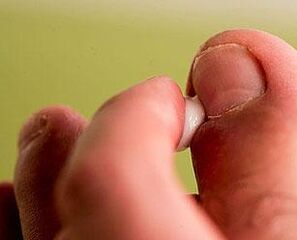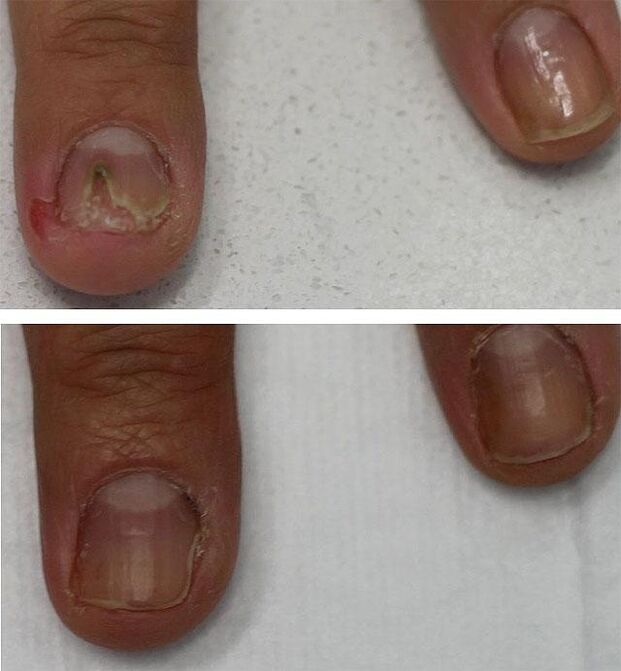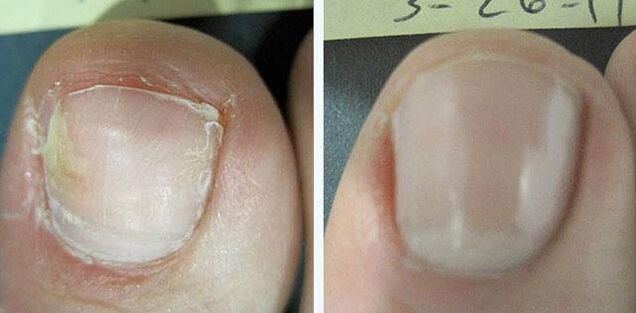
Onychomycosis is a widespread fungal nail disease (18% of the population). It affects people of all ages, and the number of adolescents and children affected has increased in the past decade. Due to the high level of contact and frequent recurrence, the treatment of nail fungus on hands and feet is a complicated and long process.
When does the infection occur?
- In households where shoes, household products (bathroom carpets) and body care products (towels, manicure sets) are commonly used;
- When visiting the swimming pool, showers, saunas and baths are available in the gym and corporate.
The pathogen of the disease
Only the correct laboratory diagnosis of the pathogen can effectively treat nail fungus. In almost 90% of cases, onychomycosis is caused by various types of dermatophytes. A particular species will affect its characteristic body parts:
- Feet and hands and nails on any part of the skin;
- Nail boards on the feet and skin in the III-IV interdigital space, the arch of the foot, the upper third of the sole, and the side of the toes.
In more rare cases, the disease is caused by other types of fungi-Trichophyton, epidermal fungi, such as yeast. In rare cases, onychomycosis can be caused by mold. These molds can affect the nail area of the first toe, mainly in people over 50.
Influencing factors
Favorable conditions for the introduction and development of infections:
- Damage to the nail plate and the surrounding skin. This usually happens due to wearing tight shoes and performing cosmetic procedures.
- Fractures of the fingers and bones of the feet or hands.
- Leg swelling caused by heart disease, atherosclerosis of the lower extremities, varicose veins, Raynaud's disease (artery spasm of the upper extremities).
- Endocrine diseases (especially diabetes).
- Pregnancy (due to hormonal changes and reduced immunity).
- The overall immunity is decreased.
- Congenital abnormalities in the formation of the stratum corneum of the skin.
- Severe and long-term chronic diseases will reduce the body's defense capabilities.
- Long-term use of corticosteroids and antibiotics, treatment of systemic and other immune diseases.
The possibility of blood and lymph spreading infection in the body has been proven.
Diagnosis of onychomycosis
The diagnosis of fungal infection is based on local and general clinical manifestations and laboratory studies.

Clinical manifestations
The symptoms are very diverse, depending on the type and type of pathogen. In addition, toe nails (80%) and hands are affected; it is less common that the nails of the lower and upper extremities fall off at the same time.
According to the nature of the nail plate change, it can be divided into 4 types of damage:
- Positive nutrition-It is characterized by the light yellow on the edge of the nail plate. Due to the epidermal stratum corneum (hyperkeratosis under the tongue), it becomes dull and thickened. The shape of the affected nail will not change for a long time.
- Hypertrophy, Nails turn yellow and thick, and the edges are loose. Horizontal stripes appear gradually. The nail plate turns gray and dark. In some cases, it (usually on the first toe) becomes thicker, longer and curved, just like a bird's claw or beak (onychomycosis).
- Shrinking-The nails are dull, gray or yellow. They changed shape and collapsed at the end edge, partially exposing the bed. The latter covers the loose layer of the stratum corneum.
- Onycholysis-Remove the nail plate from the bed board. With this form of fungal infection, the normal color remains only in the root area. The rest of the nail thins, separates from the bed, loses luster, turns yellow or turns gray.
Combination forms are often observed. The clinical manifestations listed are not for specific types of fungal lesions. They may also suffer from diseases not related to fungi.
There may also be some common manifestations: allergic rashes on the body, increased fatigue and decreased appetite. They can be explained by the ability of certain types of skin fungi to cause allergic structural reorganization and mold in the body-releasing toxins, leading to chronic systemic poisoning.
Laboratory diagnosis
It includes the collection of materials (particles of the epidermal layer, nail pieces). Pour the taken material into a caustic solution, place it at a temperature of about 20 degrees for 24 hours, and then examine it under a microscope. This technology can differentiate between fungal and non-fungal lesions. In the presence of fungi, filaments of various thicknesses and shapes, and spore groups, they can be seen under the microscope.
After that, the material is sown on a special nutrient medium for the growth of pathogens, and then its type is identified and its sensitivity to antifungal drugs is determined.
Treatment characteristics
When choosing a treatment method, special consideration should be given to the form, type and extent of the lesion, the growth rate of the nails, the general condition of the body and the side effects of the drugs used, especially in the presence of concomitant diseases. Based on these principles, the treatment of toenail fungus and hands have local or complex effects.
Local influence principle
If possible, then:
- The infection did not affect all nails;
- The damage of each infected nail board is less than half of its area;
- The process is only on the ends and sides of the board, and does not involve the roots.
- There are contraindications to the use of systemic drugs.
Local medication
It includes the use of creams, solutions or nail polishes that contain substances that soften the nail plate. They also include drugs used to treat toenail (hand) fungus, which can inhibit the growth and development of infections:
As in the first case, you can pre-apply any preparation material to soften the board and remove it layer by layer, and then apply the broad-spectrum antifungal in the form of a cream or solution twice a day. At the same time, it is necessary to rub them into the surrounding skin.

Medical hardware pedicure
Pedicure is an extra step (but not treatment! ) that can shorten the treatment time. The essence is to use router planers with attachments in the form of metal or diamond cutters. This device greatly facilitates the painless removal of previously soft nails to their bed. When the area of the nail plate is more than 60% damaged, it is recommended to use the hardware method, but do not use antifungal drugs instead of further medical treatment.
Surgery
If onychomycosis is severe and the nails are severely deformed, they can sometimes be removed by further use of antifungal drugs under general anesthesia or conductive anesthesia. The main disadvantage of this method is that the nail bed is damaged, with the result that the newly grown plate lags behind the nail bed and has an irregular shape.
Laser Treatment
The method involves heating the nails with laser radiation in a short pulse range to a temperature of 45-47 degrees, at which temperature the dermatophytes die. This procedure is most effective in the initial stage when the nail is not deformed. Depending on the severity, it is necessary to perform 1 to 8 courses of 7 to 60 days. In severe lesions, local and systemic treatments should be performed.

Systemic medication
It is suitable for multiple lesions of nails, root involvement without local exposure.
The most effective medicine for nail fungus is the tablet. Contains substances such as terbinafine, fluconazole, etc. They are prescribed for 3-4 months during the course of treatment and remain in the body for up to 9 months after the treatment is over. Due to their toxic effects on the liver, the last two drugs are used much less frequently.
Systemic treatment of kidney and liver diseases is contraindicated. During pregnancy and breastfeeding, only 1-2 nails can be treated locally, but it is best to avoid this.
























